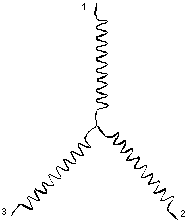
3 Lead Wye Connection

9 Lead Dual Voltage Wye Connection

3 Lead Delta Connection

9 Lead Delta Dual Voltage Connection
Wye High Voltage Connection:
L1 to 1, L2 to 2, L3 to 3
JOIN 4-7, 5-8, 6-9
Wye Low Voltage Connection:
L1 to 1-7, L2 to 2-8, L3 to 3-9
JOIN 4-5-6
Delta High Voltage Connection:
L1 to 1, L2 to 2, L3 to 3
JOIN 4-7, 5-8, 6-9
Delta Low Voltage Connection:
L1 to 1,6,7
L2 to 2,4,8
L3 to 3,5,9
Study these diagrams. They are pretty
straightforward. Using an ohmeter on a
disconnected motor,
the windings should
"ring out" as shown. Connecting 9 lead
motors "internally" and only having
3 leads in the terminal box,
is
common.
Special Case for motors
that have been rewound, or
leads
replaced.
Introducing the term
"bring out 3 leads". Often, a
motor shop will rewind a 9 lead motor and make
the 9 lead connections
"internally" or at the winding itself,
during the rewind
process. The presumption
is that the motor was connected for one voltage,
and it will return to that same service, so
providing only 3 leads is
convenient for
the electrician. However, many times, the motor
will wind
up in storage, only to return to
service in some other application. The
new
application may require the dual voltage rating
because it will
actually be powered by a
different voltage than it was originally
connected for. Introducing a second term
"pull up the leads".
Leads
are connected to the winding coil ends and then
tied down onto the
winding. Usually, an
insulating varnish coating is applied to
immobilize
the windings and insulate them.
Pulling up the leads is the process of
cutting the tie cords, and gently pulling up the
lead/coil connections.
This is usually
major surgery for the motor winding and is not
always
successful. This is also the method
used when leads are damaged and must
be
replaced. NOTE the voltage specifications on the
motor nameplate. If
there are only 3 leads,
but a connection diagram with 9 leads, this
motor
was probably changed after rewind or
lead replacement. In this case, the
UNUSED
voltage connection should be x'd out on the
nameplate. Ex.
Volts 230/460
will now read 230/XXX.